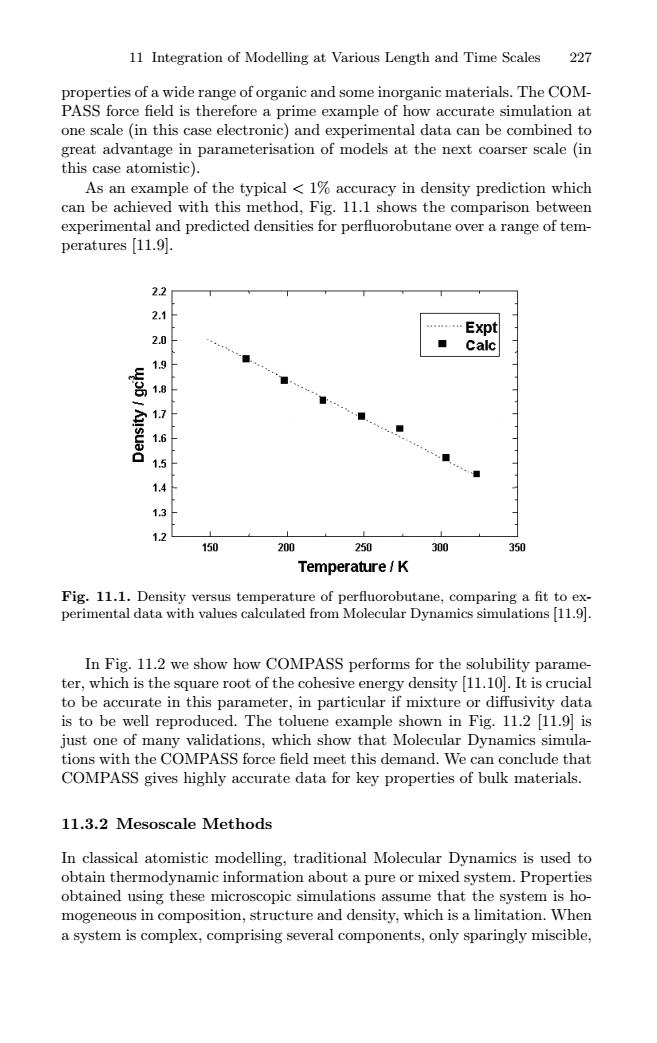正在加载图片...

11 Integration of Modelling at Various Length and Time Scales 227 properties of a wide range of organic and some inorganic materials.The COM- PASS force field is therefore a prime example of how accurate simulation at one scale (in this case electronic)and experimental data can be combined to great advantage in parameterisation of models at the next coarser scale (in this case atomistic). As an example of the typical<1%accuracy in density prediction which can be achieved with this method,Fig.11.1 shows the comparison between experimental and predicted densities for perfluorobutane over a range of tem- peratures 11.9. 2.2 2.1 Expt 2.0 Calc 19 1.8 1.6 15 ■ 14 13 1.2 150 200 250 300 350 Temperature/K Fig.11.1.Density versus temperature of perfluorobutane,comparing a fit to ex- perimental data with values calculated from Molecular Dynamics simulations[11.9]. In Fig.11.2 we show how COMPASS performs for the solubility parame- ter,which is the square root of the cohesive energy density [11.10.It is crucial to be accurate in this parameter,in particular if mixture or diffusivity data is to be well reproduced.The toluene example shown in Fig.11.2 [11.9]is just one of many validations,which show that Molecular Dynamics simula- tions with the COMPASS force field meet this demand.We can conclude that COMPASS gives highly accurate data for key properties of bulk materials. 11.3.2 Mesoscale Methods In classical atomistic modelling,traditional Molecular Dynamics is used to obtain thermodynamic information about a pure or mixed system.Properties obtained using these microscopic simulations assume that the system is ho- mogeneous in composition,structure and density,which is a limitation.When a system is complex,comprising several components,only sparingly miscible,11 Integration of Modelling at Various Length and Time Scales 227 properties of a wide range of organic and some inorganic materials. The COMPASS force field is therefore a prime example of how accurate simulation at one scale (in this case electronic) and experimental data can be combined to great advantage in parameterisation of models at the next coarser scale (in this case atomistic). As an example of the typical < 1% accuracy in density prediction which can be achieved with this method, Fig. 11.1 shows the comparison between experimental and predicted densities for perfluorobutane over a range of temperatures [11.9]. Fig. 11.1. Density versus temperature of perfluorobutane, comparing a fit to experimental data with values calculated from Molecular Dynamics simulations [11.9]. In Fig. 11.2 we show how COMPASS performs for the solubility parameter, which is the square root of the cohesive energy density [11.10]. It is crucial to be accurate in this parameter, in particular if mixture or diffusivity data is to be well reproduced. The toluene example shown in Fig. 11.2 [11.9] is just one of many validations, which show that Molecular Dynamics simulations with the COMPASS force field meet this demand. We can conclude that COMPASS gives highly accurate data for key properties of bulk materials. 11.3.2 Mesoscale Methods In classical atomistic modelling, traditional Molecular Dynamics is used to obtain thermodynamic information about a pure or mixed system. Properties obtained using these microscopic simulations assume that the system is homogeneous in composition, structure and density, which is a limitation. When a system is complex, comprising several components, only sparingly miscible